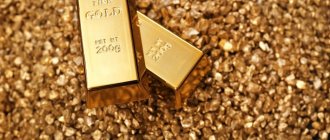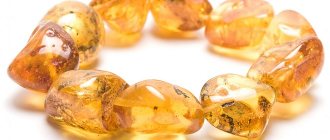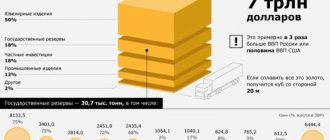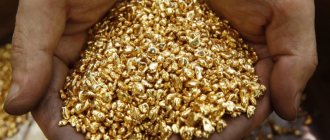Good afternoon We know a lot about the American gold rush - the unorganized mining of the precious metal by prospectors, mostly poor adventurers. Writers (Jack London, Jules Verne) and Hollywood cinema contributed to the mythologization of the gold rush in the United States. Stories about the tragic fate of the indigenous population of America - the Indians - played a role.
Gold deposits in Russia are also numerous. We have not been spared by the general obsession with wealth. The Russian gold rush lasted from the beginning of the 19th century and covered Siberia and the Far East - at that time remote, undeveloped territories.
There was a legend about Yegor, nicknamed Lesnoy, a former convict who was one of the first to begin independent mining in the Berikul River basin, but never reported where exactly he could find gold.
Where does gold come from?
Metals with an atomic mass of more than 55 units (heavier than iron), which cannot be formed inside stars, arise as a result of gamma-ray bursts - releases of energy in space during supernova explosions. Gold came to Earth with asteroids many years ago, when our planet was just being formed and had no atmosphere. Most of the heavy elements sank below the Earth's surface and formed the core.
There are few precious metals on the surface. Their main volume is located in the mantle - the substance between the earth's crust and core. In the upper layers of the mantle, a hot melt is formed - magma, which in some places penetrates the surface of the Earth. There it hardens and turns into solid rock, containing almost the entire periodic table.
Magma is heterogeneous, hardens unevenly - refractory substances coexist with low-melting substances, and the latter continue to circulate inside the solidified former. This is how gold veins are formed within the rock.
Classification of gold deposits
There are two types of deposits. They are divided into:
- primary, they are also radical;
- secondary - alluvial.
Indigenous
Primary deposits are the same fragments of magma ejected onto the surface of the globe. It happens that gold is present in the rock in the form of veins and nuggets, but more often it is alloyed with other elements: gold ores with copper, quartz, iron and sulfur compounds, and polymetallic alloys are common.
The main deposits of gold mined in Russia are concentrated in primary deposits.
Alluvial
Secondary deposits appeared as a result of destruction (weathering) of primary ones. Weathering refers to the impact not only of air currents, but also of water, temperature changes and even the activity of bacteria. It was alluvial deposits that were so diligently developed by amateur, lone miners.
Until the end of the 19th century, gold was mined mainly from placers - by washing (sliding), which is possible due to the relative gravity of gold. Lighter impurities were washed away with water, leaving gold sand in the washing trays, which was melted into ingots and products.
At the end of the 19th century - during the era of the birth of the scientific and technological revolution - technologies appeared that made it possible to effectively develop igneous rock. This has affected the scale of gold mining: it is believed that 60% of all gold mined in the entire history of mankind is metal produced over the past 150 years.
conclusions
Of interest are the “lattice” statistics separately for the latitudinal and longitudinal distributions of 46 Russian gold mines (according to the “gold belts”).
Latitudinal distribution of gold mines in the Russian Federation
- from 70 to 65 N. — 4 (9% ~10)
- from 65 to 60 N. — 13 (28% ~30)
- from 60 to 55 N. — 11 (24% ~20)
- from 55 to 50 N. — 18 (39% ~40)
Longitudinal distribution of gold mines in the Russian Federation
- from 60 to 65 east. — 4 (9%)
- from 65 to 70 N. - 12%)
- from 85 to 90 east. — 2 (4%)
- from 90 to 95 east. — 3 (7%)
- from 100 to 105 east. - 12%)
- from 115 to 120 east. — 10 (22%)
- from 120 to 125 east. - 12%)
- from 125 to 130 east. - 12%)
- from 130 to 135 east. — 2 (4%)
- from 135 to 140 east. — 3 (7%)
- from 140 to 145 east. - 12%)
- from 145 to 150 east. — 3 (7%)
- from 150 to 155 east. — 4 (9%)
- from 155 to 160 east. — 4 (9%)
- from 160 to 165 east. — 3 (7%)
- from 165 to 170 east. — 2 (4%)
- from 170 to 175 east. - 12%)
Thus, the greatest concentration of mines falls on the range of geographical coordinates from 50 to 55 N latitude. and from 115 to 120 E. These mines are marked with an asterisk. They are included in the 4th gold-bearing zone, which coincides with the 4th gas-bearing zone (60 N 120 E - Yakutia). It may be necessary to change the coordinate of this GPS zone to 55 N latitude. 120 east
The parallel itself is 60° N. is a well-known latitudinal lineament stretching across the entire territory of Russia (the so-called “Okhotsk-Vychegda lineament”
) [also called
Okhotsk-Moscow
(No. 17 on the map of Eurasian lineaments)].
The meridian is 120° east. also a lineament (No. 10 - Sulawesi).
Gold mining map
In this article I will consider only a few regions of Russia - keep in mind, there are many more, especially in the Far East, Far North and Siberia.
Deposits of the European part of the Russian Federation
The largest amount of gold was deposited in areas where magma often reached the land surface - now there are mountains and hills, like in the Urals and Magadan. Therefore, in Central Russia there is almost no search for gold.
There are some placer deposits in the Kostroma region, on the Chabra and Chashchevaya rivers, but they are unlikely to be of interest to large gold mining companies. However, this is not a hindrance for amateur enthusiasts: if you want to try to wash a couple of grams of precious metal in the river, know that this is possible.
West of the Ural Range there are only three industrial gold mining provinces:
- Dnieper-Donetsk zone;
- Karelo-Kola;
- Caucasian.
The gold mining potential of these zones is the smallest of all those located in Russia.
Deposits of the Urals and Trans-Urals
The Ural gold mining province is fourth in the Russian ranking. It is inferior to the Baikal-Vitim, Altai-Sayan and Verkhoyansk-Kolyma provinces. The development of deposits in the Urals began in the 18th century, and by the end of the 20th century there were already more than 300 mines operating here.
The gold mining industry is most interested in primary deposits, but in the Urals and the West Siberian Plain there are many placers - mainly alluvial, that is, accumulated in river beds, “alluvial deposits”. The largest of them are located in the Perm, Chelyabinsk and Sverdlovsk regions.
Deposits of Eastern Siberia
Eastern Siberia is a region of Russia rich in precious deposits. Transbaikalia has been developed since the middle of the 19th century. The largest center of gold mining has always been the Irkutsk region: the village of Bolshie Koty, modern deposits with the picturesque names Sukhoi Log and Chertovo Koryto.
Single miners were content with working in the stream with a shovel and a tray, while organized groups dug orts - underground tunnels that were eventually connected into a network. In such a mine, workers (often convicts) heated the rock from morning to night.
It was dangerous to be in the orts: despite the fortifications, tunnels and passages kept collapsing, burying people under them. No one knows how many of these mass graves have survived - the comrades of the victims erected an impromptu monument and left, refusing to develop the deadly mine.
Prospects for precious metals mining
As mentioned above, gold is the basis of today's economy. Every year it is valued more and more. The jewelry industry is one of the most profitable areas in business today, and the items and products they provide are a high-status and expensive gift. This has been the case from time immemorial, and even in the age of industrial states and high information technologies, the tradition has retained its relevance. And now, with the adoption of amendments to the law, everyone can try themselves as a gold miner at the amateur level, or pave the way to the top of the most expensive industry in the world.
The most famous deposits
Sukhoi Log
Sukhoi Log is a deposit in the Lensky gold mining district (Irkutsk region). In its depths there are 2,500 tons of gold and 1,500 tons of silver (according to rough estimates). The concentration of pure precious metal in the ore is low; there are sections of the rock with a gold content of less than 1 g/t. The geological and industrial type of Sukhoi Log is a gold sulfide deposit, that is, the predominant impurities in the rock are sulfur compounds, mainly pyrite (iron pyrite). The average gold content in the ore is 2.7 g/t.
Sukhoi Log was opened in 1961 and is still being developed. Its reserves account for 15–28% (according to various sources) of all deposits in Russia.
Berezovskoe
The Berezovskoye deposit is a gold-sulfide-quartz deposit. It is located in the Sverdlovsk region (Middle Urals) and is considered one of the first discovered in Russia, standing at the origins of our gold mining. In 1748, the village of Berezovsky arose near the mine - now a satellite city of Yekaterinburg. The Berezovskoye field is being developed underground.
Vorontsovskoe
The Vorontsovskoye deposit (Middle Urals, 12 km from Krasnoturinsk) was discovered in 1985 by geologists and has a gold-arsenic-sulfide technological type. It is developed using an open-pit method - people and machines extract ore from a quarry.
Natalka
Natalka is located 390 km from Magadan, in the Tenkinsky district of the region. This is a gold-quartz deposit, the second largest resource in Russia after Sukhoi Log. The average gold content in the ore is 1.7 g/t.
The Natalka gold deposit was also discovered by geologists in the 1940s. It bears the name of Natalya, the daughter of D.T. Aseev, who discovered a gold-bearing stream at the site of future mining.
Which deposit is the largest?
The largest gold deposit in Russia is the above-mentioned Sukhoi Log. It has not yet been fully developed and has long been considered unpromising due to the fact that mining is complicated by the uneven, sometimes low, gold content of the ore. People have yet to master it.
History of gold mining in the Russian Federation
Gold mining in the Russian Federation for private individuals was prohibited in 1954. During Stalin's time, working in this area was a little easier. The state provided additional payments for gold seekers and gave them the right to develop the richest gold mines. To intensify labor, housing, vouchers to sanatoriums and resorts, etc. were provided.
Before the Great Patriotic War, every adult citizen without a criminal record could be employed in gold mining. About 120 thousand gold miners were employees of non-state enterprises.
State income before and after the amendment
Large companies mined enough gold to cover the needs of the state, and even export some abroad. However, small deposits still made up a significant part, but their location was irrational for organizing large enterprises in each individual area.
After the adoption of the law, a new type of gold mining appeared - “mobile”. Private organizations act faster, are able to move long distances, and act locally, because they do not use bulky equipment and are not tied to one point. State income in 2 years, after the adoption of the law, increased by about 21%, which is very much for such a short period.
World gold production and Russia’s role in it
In 2009, Russia ranked 4th in the world, its share was only 7.2% of the total volume of gold mined in the world. At the moment, Russia is in second place, with an indicator of 11.4% and a volume of 402 tons of gold per year.
Quantity of gold as a political tool
The value of money is secured by gold reserves, being its equivalent and a convenient tool for barter and trade relations. The 2007 crisis showed how much the position of a country whose currency is the most popular in the world can change. However, the price of gold did not fall at all, but rather increased slightly. If you look at the chart on a 100-year scale, you can see that the price of gold has fluctuated at times, but overall the upward trend is positive.
How and where gold deposits can be developed
In many countries of the world (Australia, Finland, some US states), the government solved the problem of private mining simply - it resolved it. All you have to do is buy a license and you’re welcome to the stream with your tray. Citizens are allowed to use what they have obtained at their own discretion.
It's different in Russia. It is almost impossible to become legalized as a gold miner, Art. 191 of the Criminal Code of the Russian Federation is in effect, and the found metal must be handed over to the state. The bill on civil liberties and the issuance of licenses has been considered in the State Duma since 2009, but has not yet been adopted.
A single miner should focus on the map of alluvial deposits, of which there are many in the Urals and Transbaikalia. There are abandoned mines, the residual deposits of which are of no interest to industrial developers. You can find gold in river basins:
- Sanarka;
- Lena;
- Bodaibo;
- Big Chanchik;
- Bom;
- Talga et al.
Also see below how gold is mined by a prospector:
How to get a gold mining license
A license for gold mining in the Russian Federation was issued only to legal entities. Individuals were prohibited from removing metal from the subsoil. This provision is regulated by Article 191 of the Criminal Code of the Russian Federation. To mine gold, registration of an LLC or OJSC was required.
This was the case until 2021. At the initiative of Dmitry Medvedev, amendments were made to the legislative framework, according to which private individuals can also obtain a license.
Since the soil from which metals are extracted belongs to the state, issuing permits is included in the list of responsibilities of the state agency RosNedra.
It has branches and divisions such as ". In some cases, the Ministry of Nature of the Russian Federation is involved in the process of issuing a license. It is responsible for auctions for the rights to develop particularly large deposits. Thus, in 2016, the Ministry of Natural Resources decided the fate of Sukhoi Log (one of the largest gold sources in Russia). When purchasing an enterprise for the extraction of gold or precious sands, you do not have to obtain a license, but re-register the old one in your name.
A license for individuals is issued only for those places that contain less than 10 kilograms of gold raw materials.
Features of the license for private owners
If the plan is exclusively for gold mining, the license period will be no more than 20 years.
If, in addition to mining, geological research and soil analysis take place, the period can be 25 years. It is not difficult to calculate that a license for geological research without the possibility of gold mining is issued for 5 years. All of the above applies to legal entities. For private individuals, the license period is 5 years, and they are also subject to restrictions on the choice of site for production. The use of powerful equipment (bulldozers, drilling machines) is also prohibited. The motivation for this restriction remains a mystery, because the more gold private owners extract, according to the license, the greater the tax levy will be paid. For individuals this is a good income, while for industry leaders it is “small fish”.
License cost for individuals
The price of a gold mining license depends on the method of obtaining it. There are a number of companies that provide document preparation services for only 100 -200 thousand rubles.
Interesting: How much does a gram of gold cost in a pawnshop?
All that is required from the client is material resources; all other concerns are handled by the company providing the services. If gold is extracted from ore, $15-20 million will be required. Against the background of such a contribution, 100 thousand rubles does not seem such a big amount. Such a high entry threshold allows only those who clearly see the goal and go towards it to engage in mining, weeding out scammers and fly-by-night companies.
How to save money?
If you apply for a license yourself, providing all the documents, running through the authorities, the cost will be 7,500 rubles. Re-registration will cost 750 rubles. It is worth understanding that in this case the deadlines will be much longer, since there is no clearly established algorithm and the shortest path to obtaining documentation has not been worked out (like with professional agencies).









